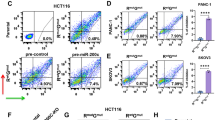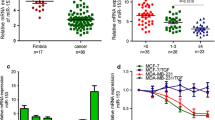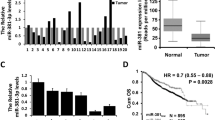Abstract
Purpose
Dysregulation of microRNAs (miRNAs) are not only involved in the formation of malignant tumors but also in the processes of differentiation and aggressiveness. However, current methods for detecting miRNA expression have major disadvantages, such as being invasive and non-reproducible. The epithelial-mesenchymal transition (EMT) has been implicated as a pivotal event in the metastasis, stemness, and chemoresistance of malignant tumors.
Procedures
In our study, we constructed a new reporter gene, Luc2/tdT_miR200c_3TS, to examine the in vitro and in vivo expression of miR-200c, an EMT-associated miRNA. Quantitative real-time PCR was used to measure the expression levels of miR-200c and EMT-related mRNA, and luciferase assay and bioluminescence imaging were used to measure the luciferase activities in vitro and in vivo, respectively.
Results
We found that the expression level of miR-200c was negatively associated with cell migration and invasion. Luciferase activities were regulated by the differential expression levels of miR-200c and EMT process.
Conclusions
Our results demonstrate that Luc2/tdT_miR200c_3TS may be a useful tool for monitoring the expression level of miR-200c at both the cellular level and in living animals, thereby providing a potential high-throughput approach for anticancer drug screening.





Similar content being viewed by others
References
Li S, Zhang H, Ning T, Wang X, Liu R, Yang H, Han Y, Deng T, Zhou L, Zhang L, Bai M, Wang X, Ge S, Ying G, Ba Y (2016) MiR-520b/e regulates proliferation and migration by simultaneously targeting EGFR in gastric cancer. Cell Physiol Biochem 40:1303–1315
Bi ZM, Zhou QF, Geng Y, Zhang HM (2016) Human umbilical cord mesenchymal stem cells ameliorate experimental cirrhosis through activation of keratinocyte growth factor by suppressing microRNA-199. Eur Rev Med Pharmacol Sci 20:4905–4912
Shibue T, Weinberg RA (2017) EMT, CSCs, and drug resistance: the mechanistic link and clinical implications. Nat Rev Clin Oncol 14:611–629
Yeh TC, Huang TT, Yeh TS, Chen YR, Hsu KW, Yin PH, Lee HC, Tseng LM (2016) miR-151-3p targets TWIST1 to repress migration of human breast cancer cells. PLoS One 11:e0168171
Bertoli G, Cava C, Castiglioni I (2015) MicroRNAs: new biomarkers for diagnosis, prognosis, therapy prediction and therapeutic tools for breast cancer. Theranostics 5:1122–1143
Cochrane DR, Spoelstra NS, Howe EN, Nordeen SK, Richer JK (2009) MicroRNA-200c mitigates invasiveness and restores sensitivity to microtubule-targeting chemotherapeutic agents. Mol Cancer Ther 8:1055–1066
Lo WL, Yu CC, Chiou GY, Chen YW, Huang PI, Chien CS, Tseng LM, Chu PY, Lu KH, Chang KW, Kao SY, Chiou SH (2011) MicroRNA-200c attenuates tumour growth and metastasis of presumptive head and neck squamous cell carcinoma stem cells. J Pathol 223:482–495
Vlachos IS, Paraskevopoulou MD, Karagkouni D, Georgakilas G, Vergoulis T, Kanellos I, Anastasopoulos IL, Maniou S, Karathanou K, Kalfakakou D, Fevgas A, Dalamagas T, Hatzigeorgiou AG (2015) DIANA-TarBase v7.0: indexing more than half a million experimentally supported miRNA:mRNA interactions. Nucleic Acids Res 43:D153–D159
Bednar B, Zhang GJ, Williams DL Jr, Hargreaves R, Sur C (2007) Optical molecular imaging in drug discovery and clinical development. Expert Opin Drug Discov 2:65–85
Ghorbani S, Talebi F, Chan WF, Masoumi F, Vojgani M, Power C, Noorbakhsh F (2017) MicroRNA-181 variants regulate T cell phenotype in the context of autoimmune neuroinflammation. Front Immunol 8:758
Sekar TV, Mohanram RK, Foygel K, Paulmurugan R (2013) Therapeutic evaluation of microRNAs by molecular imaging. Theranostics 3:964–985
Oh SW, Hwang DW, Lee DS (2013) In vivo monitoring of microRNA biogenesis using reporter gene imaging. Theranostics 3:1004–1011
Patel MR, Chang YF, Chen IY, Bachmann MH, Yan X, Contag CH, Gambhir SS (2010) Longitudinal, noninvasive imaging of T-cell effector function and proliferation in living subjects. Cancer Res 70:10141–10149
Wang K, Liu CY, Zhou LY, Wang JX, Wang M, Zhao B, Zhao WK, Xu SJ, Fan LH, Zhang XJ, Feng C, Wang CQ, Zhao YF, Li PF (2015) APF lncRNA regulates autophagy and myocardial infarction by targeting miR-188-3p. Nat Commun 6:6779
Ko HY, Hwang do W, Lee DS, Kim S (2009) A reporter gene imaging system for monitoring microRNA biogenesis. Nat Protoc 4:1663–1669
Chen ZH, Zhao RJ, Li RH, Guo CP, Zhang GJ (2013) Bioluminescence imaging of DNA synthetic phase of cell cycle in living animals. PLoS One 8:e53291
Liu J, Wei XL, Huang WH, Chen CF, Bai JW, Zhang GJ (2012) Cytoplasmic Skp2 expression is associated with p-Akt1 and predicts poor prognosis in human breast carcinomas. PLoS One 7:e52675
Chaudhry P, Fabi F, Singh M, Parent S, Leblanc V, Asselin E (2014) Prostate apoptosis response-4 mediates TGF-beta-induced epithelial-to-mesenchymal transition. Cell Death Dis 5:e1044
Wan L, Pantel K, Kang Y (2013) Tumor metastasis: moving new biological insights into the clinic. Nat Med 19:1450–1464
Arranz A, Ripoll J (2015) Advances in optical imaging for pharmacological studies. Front Pharmacol 6:189
Berx G, Raspe E, Christofori G et al (2007) Pre-EMTing metastasis? Recapitulation of morphogenetic processes in cancer. Clin Exp Metastasis 24:587–597
Wei SC, Yang J (2016) Forcing through tumor metastasis: the interplay between tissue rigidity and epithelial-mesenchymal transition. Trends Cell Biol 26:111–120
Dalerba P, Cho RW, Clarke MF (2007) Cancer stem cells: models and concepts. Annu Rev Med 58:267–284
Knezevic J, Pfefferle AD, Petrovic I, Greene SB, Perou CM, Rosen JM (2015) Expression of miR-200c in claudin-low breast cancer alters stem cell functionality, enhances chemosensitivity and reduces metastatic potential. Oncogene 34:5997–6006
Kim HJ, Chung JK, Hwang do W et al (2009) In vivo imaging of miR-221 biogenesis in papillary thyroid carcinoma. Mol Imaging Biol 11:71–78
Acknowledgements
This work was supported by the National Natural Science Foundation of China (Nos. 81501539 and 81320108015) and the Natural Science Foundation of Guangdong Province (Nos. 2015A030310211 and 2016A030312008). Guo-Jun Zhang is a recipient of the Chang Jiang Scholar’s award granted by the Ministry of Education of China.
Author information
Authors and Affiliations
Corresponding author
Ethics declarations
Conflict of Interest Statement
All of the animal experiments described in this study were approved by the Animal Experimental Ethics Committee of Shantou University Medical College (Shantou, China).
The authors had no conflicts of interest.
Electronic supplementary material
ESM 1
(PDF 402 kb).
Rights and permissions
About this article
Cite this article
Liu, J., Shen, JX., He, D. et al. Bioluminescence Imaging for Monitoring miR-200c Expression in Breast Cancer Cells and its Effects on Epithelial-Mesenchymal Transition Progress in Living Animals. Mol Imaging Biol 20, 761–770 (2018). https://doi.org/10.1007/s11307-018-1180-4
Published:
Issue Date:
DOI: https://doi.org/10.1007/s11307-018-1180-4




